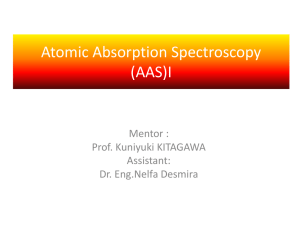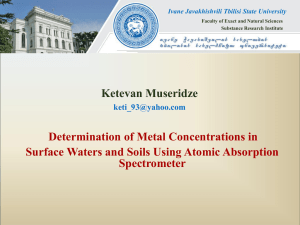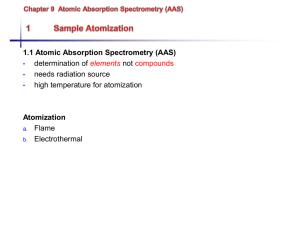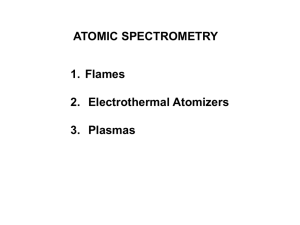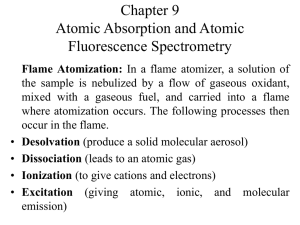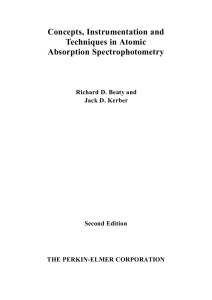Homework 1-xiaodong
advertisement
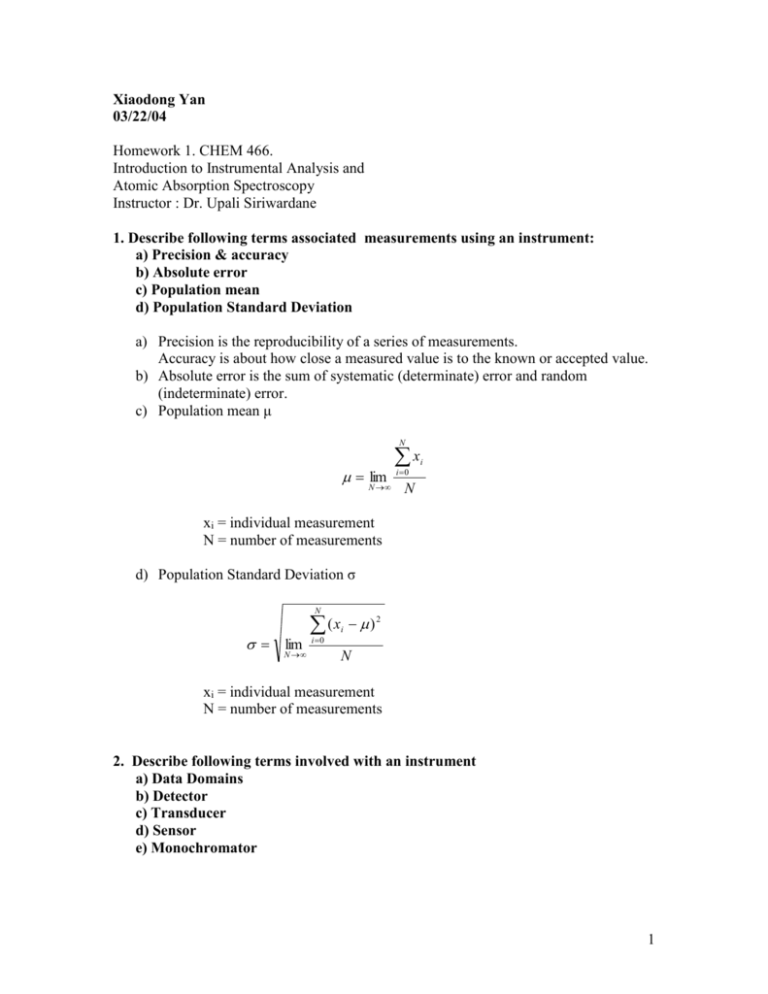
Xiaodong Yan 03/22/04 Homework 1. CHEM 466. Introduction to Instrumental Analysis and Atomic Absorption Spectroscopy Instructor : Dr. Upali Siriwardane 1. Describe following terms associated measurements using an instrument: a) Precision & accuracy b) Absolute error c) Population mean d) Population Standard Deviation a) Precision is the reproducibility of a series of measurements. Accuracy is about how close a measured value is to the known or accepted value. b) Absolute error is the sum of systematic (determinate) error and random (indeterminate) error. c) Population mean μ N lim N x i 0 i N xi = individual measurement N = number of measurements d) Population Standard Deviation σ N lim N (x i 0 i )2 N xi = individual measurement N = number of measurements 2. Describe following terms involved with an instrument a) Data Domains b) Detector c) Transducer d) Sensor e) Monochromator 1 a) Data Domain: way of encoding analytical response in electrical or non-electrical signals. b) Detector (general): device that indicates change in environment. c) Transducer (specific): device that converts non-electrical to electrical data. d) Sensor (specific): device that converts chemical to electrical data 3. Describe following terms and methods associated with instrumental analysis a) Standard sample b) Blank sample c) Calibration curve d) Dynamic range. e) Linear regression f) Standard Addition Method (a) Standard sample: is a sample with known concentration of analyte which is otherwise similar to composition of unknown sample. (b) Blank sample: is one type of a standard without the analyte. c) Calibration curve: a plot of signal vs conc. for a set of standards. d) Dynamic range: the linear part of the plot. e) Linear regression: is used to find the best straight line through experimental data points. f) Standard Addition Method: it consists of at least three steps. First, measure the signal from the sample; second, add a known conc. of analyte (the spike) to sample; third, remeasure the signal. With only one spike, you must assume linear response of the signal with conc. Additional spiking improves the precision and proves that the signal is linear with conc. Standard addition is especially useful when matrix effects are severe or when concentrations are near the detection limit. For the best precision, the first spike should at least double the analyte conc. in the sample. 4. Describe following terms associated with instrumental analysis a) Sensitivity b) S/N ratio c) Fourier Transformation (FT) in increasing sensitivity and S/N ratio d) Detection Limit, DOL, and DOQ. e) Matrix and interference a) Sensitivity: the slope of the linear part b) S/N ratio: signal to noise ratio. It is a useful measure for data or instrument performance; higher S/N is desirable. c) Fourier Transformation (FT) in increasing sensitivity and S/N ratio d) Detection Limit: The limit of detection (LOD) is the conc. at which one is 95% confident the analyte is present in the sample. The limit of quantitation (LOQ) is the smallest conc. at which a reasonable precision can be obtained 2 e) Matrix and interference: matrix is the solvent of the sample. If the matrix emission overlaps or lies too close to the emission of the sample, it will cause interence. 5. Describe following atomization techniques and compare their performance: a) Flame atomization b) Electrothermal atomization (graphite furnace method) a) Flame atomization: the sample is sprayed into a gas flame and be atomized. It is the simplest atomization of gas/solution/solid sample. It has a good reproducibility(precision)(<1%), but relatively low sensitivity. b) Electrothermal atomization (graphite furnace method): small volume of sample is evaporated at low temperature and then ashed at higher temperature in an electrically heated graphite cup. After ashing, the current is increased and the sample is atomized. It has superior sensitivity (10-10 – 10-13 g analyte) but less reproducible (5-10%) 6. Describe how a hollow cathode lamp work as a radiation source for atomic absorption spectrometer. Hollow-cathode lamps are a type of discharge lamps that produce narrow emission from atomic species. They get their name from the cup-shaped cathode, which is made from the element of interest. The electric discharge ionizes rare gas atoms, which are accelerated into the cathode and sputter metal atoms into the gas phase. Collisions with gas atoms or electrons excite the metal atoms to higher energy levels, which decay to lower levels by emitting light. Schematic of a hollow-cathode lamp 7. Describe how single and double beam atomic absorption spectrometers correct absorption or scattering due to flame. If only a single beam is used to pass through the atom cell, a blank reading containing no analyte (substance to be analysed) would have to be taken first, setting the absorbance at zero. If the intensity of the source changes by the time the sample is put in place, the measurement will be inaccurate. In the double beam instrument there is a 3 constant monitoring between the reference beam and the light source. To ensure that the spectrum does not suffer from loss of sensitivity, the beam splitter is designed so that as high a proportion as possible of the energy of the lamp beam passes through the sample. 8. Describe how two line, continuum-source and Zeeman-effect correct the back ground absorption in atomic absorption due to spectrometers. Background absorption arises from the fact that not all of the matrix materials in a sample are necessarily 100% atomized. Since atoms have extremely narrow absorption lines, there are few problems involving interferences where one element absorbs at the wavelength of another. Even when an absorbing wavelength of another element falls within the spectral bandwidth used, no absorption can occur unless the light source produces light at that wavelength, i.e., that element is also present in the light source. However, undissociated molecular forms of matrix materials may have broadband absorption spectra, and tiny solid particles in the flame may scatter light over a wide wavelength region. When this type of nonspecific absorption overlaps the atomic absorption wavelength of the analyte, background absorption occurs. To compensate for this problem, the background absorption must be measured and subtracted from the total measured absorption to determine the true atomic absorption component. a) Two line: While now virtually obsolete, an early method of manual background correction illustrates clearly the nature of the problem. With the ‘‘two line method’’, background absorption, which usually varies gradually with wavelength, was independently measured by using a nonabsorbing emission line very close to the atomic line for the analyte element, but far enough away so that atomic absorption was not observed, as illustrated in Figure 8a. By subtracting the absorbance measured at the nonabsorbing line from the absorbance at the atomic line, the net atomic absorption was calculated. Nearby, nonabsorbing lines are not always readily available, however, and inaccuracies in background correction will result if the wavelength for background measurement is not extremely close to the 4 resonance line. Therefore, for accuracy, as well as convenience, a different method was needed. Figure 8a. Two-line background correction. b) Continuum source background correction is a technique for automatically measuring and compensating for any background component which might be present in an atomic absorption measurement. This method incorporates a continuum light source in a modified optical system, illustrated in Figure 8b1. The broad band continuum (‘‘white’’ light) source differs from the primary (atomic line) source in that it emits light over a broad spectrum of wavelengths instead of at specific lines. From Figure 8b2, it can be seen that atomic absorption, which occurs only at very discrete wavelengths, will not measurably attenuate the emission from the continuum source. However, background absorption which has very broad absorption spectra will absorb the continuum emission as well as the line emission. As shown in Figure 8b3, light from both the primary and continuum lamps is combined and follows a coincident path through the sample, through the monochromator, and to the detector. The two lamps are observed by the detector alternately in time, and as illustrated in Figure 3-9, instrument electronics separate the signals and compare the absorbance from both sources. An absorbance will be displayed only where the absorbance of the two lamps differs. Since background absorption absorbs both sources equally, it is ignored. True atomic absorption, which absorbs the primary source emission and negligibly absorbs the broad band continuum source emission, is still measured and displayed as usual. 5 Figure 8b1: Continuum Source Background Corrector. Figure 8b2: Atomic and background absorption with a primary (line) source and a continuum (broadband) source. Figure 8b3: Simplified diagram c) For those applications where the limitations of the continuum source approach are significant to the analysis, the Zeeman background correction system may be preferable. Zeeman background correction uses the principle that the electronic energy levels of an atom placed in a strong magnetic field are changed, thereby changing the atomic spectra which are a measure of these energy levels. When an atom is placed in a magnetic field and its atomic absorption profile observed with polarized light, the normal single-line atomic absorption profile is split into two or more components symmetrically displaced about the normal position. The spectral nature of background absorption, on the other hand, is usually unaffected by a 6 magnetic field. By placing the poles of an electromagnet around the atomizer and making alternating absorption measurements with the magnet off and then on, the uncorrected total absorbance (magnet off) and ‘‘background only’’ absorbance (magnet on) can be made. The automatic comparison made by the instrument to compensate for background correction is similar to that for the continuum source technique, except that only the one atomic line source is used. As a result, there are no potential problems with matching source intensities or coincident alignment of optical paths. Also, background correction is made at the analyte wavelength rather than across the entire spectral bandwidth, as occurs with continuum source background correction. With Zeeman background correction, the emission profile of the line source is identical for both AA and background measurements. As a result, most complex structured background situations can be accurately corrected with Zeeman background correction. 9. Describe following interferences in atomic absorption and how it is minimized. a) Spectral interferences b) Chemical interferences a) Spectral interferences: Spectral interferences are those in which the measured light absorption is erroneously high due to absorption by a species other than the analyte element. The most common type of spectral interference in atomic absorption is ‘‘background absorption.’’ This can be minimized by two line, continuum-source and Zeeman-effect correction method described in the above question. b) Chemical interferences: this happened at the atomization process. In this step, sufficient energy must be available to dissociate the molecular form of the analyte to create free atoms. If the sample contains a component which forms a thermally stable compound with the analyte that is not completely decomposed by the energy available in the flame, a chemical interference will exist. There are two means of dealing with this problem. One is to eliminate the interference by adding an excess of another element or compound which will also form a thermally stable compound with the interferent. There is a second approach to solving the chemical interference problem. Since the problem arises because of insufficient energy to decompose a thermally stable analyte compound, the problem can be eliminated by increasing the amount of energy; that is, by using a hotter flame. 10. Describe following chemical interferences due to: a) Low volatile compounds b) dissociation equilibria c) Ionization equilibira a) Low volatile compounds: formation of low volatility (refractory) compounds - do not dissociate; inhibits the volatilization of the compound within the flame Example: refactory oxides with Cr, W, Al anion interference (SO4 2- , PO4 3- ) with 7 Mg, Ca cation interference (Al in AlO2) with Mg Solution: use a hotter flame analyst can add chemicals to minimize this effect: protective agent – a complexant added to keep metal in volatile form, e.g., EDTA for Ca, Mg releasing agents – a substance added which will preferentially react with interferent, e.g., Sr or La for Ca b) dissociation equilibria - formation of compounds between metal and other components in flame (O, Cl). Solution: use equilibrium to promote atomization keep flame chemistry constant (either oxidizing or reducing) samples and standards should have same matrix composition (matrix matching) c) ionization equilibria - some ions will be produced by the heat of the flame - ions have a different spectrum from neutral atoms • Most serious for Mg, Ca, Na, Li, K, Sr • Result is non-linear calibration • Most serious under high temperature (C2H2/N2O) and low analyte concentration • At high concentration, the [e-] increases, driving reaction backwar ionization suppressor - easily ionized element (e.g., Na, K, Cs) added to sample to suppress ionization 8

